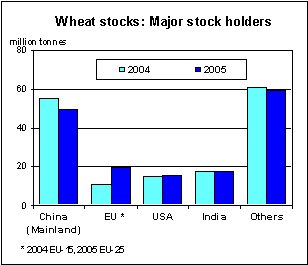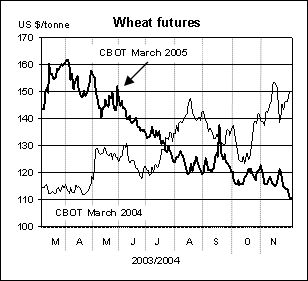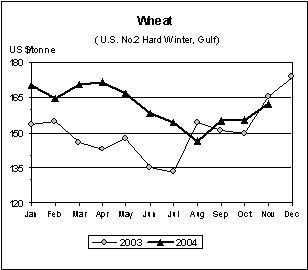


 |
 |
|
 |
||
|
|
||
|
|
|
| food outlook | |
| No. 4 | Rome, December 2004 |
|
WheatWheat production
Source: FAO. Note: Totals computed from unrounded data.
As of late-November, most of the main 2004 wheat harvests were complete, and planting of the 2005 winter crops was well underway or already completed in most major producing countries in the northern hemisphere. Early prospects are generally favourable for the newly-sown crops and tentative estimates point to a larger area sown in some countries. FAO’s forecast for world wheat production in 2004 now stands at a record 620.4 million tonnes, 7 million tonnes more than the previous forecast in September and about 11 percent up from 2003. The estimate for output in Europe has been raised significantly since September, increasing the already notable recovery in this region’s output reported earlier, which has overshadowed most other regional variations this year. In Far East Asia, wheat production in 2004 was favoured by generally good growing conditions. In China, latest information confirms an aggregate (winter and spring) output of some 91 million tonnes, 6 percent up from the previous year after record yields more than offset a continuation of the downward trend in plantings. This downward trend has halted, however, with this autumn’s wheat planting. Early estimates indicate that the area of winter wheat (which accounts for the bulk of the aggregate wheat production) recently planted for harvest in 2005 has increased by about 5 percent, or 1 million hectares, from last year’s level as a result of attractive prices and favourable planting conditions. In India, the 2004 wheat output is officially estimated at about 73 million tonnes, 12 percent up from 2003, reflecting a significant increase in area and a recovery of yields. Planting of the winter wheat crop for harvest next year is underway under generally favourable weather conditions. Pakistan also harvested a good wheat crop in 2004 reflecting favourable weather. However, conditions for the current winter wheat planting operations are reported to be unfavourable because of insufficient soil moisture. In the Asian CIS countries, the 2004 wheat harvest is complete and aggregate output of the subregion is estimated at some 21 million tonnes, about 2 million tonnes down from last year. The decline in output is mainly due to a reduction in the land cultivated with wheat and adverse spring weather in Kazakhstan, the main producing country of the group. In the Asian Near East, the aggregate 2004 wheat output was 5 percent less than the previous year’s crop. Although good harvests were gathered in the major producers Turkey and in the Islamic Republic of Iran, drought adversely affected output in Afghanistan, where output dropped to about half of the previous year’s record level, and shortages of inputs limited production in Iraq. Early indications for the 2005 crop are somewhat unfavourable. Planting in Turkey continues to be hampered by lack of sufficient rainfall and the situation was similar in the Islamic Republic of Iran until the arrival of rains in west of the country (the major wheat producing area) in early November somewhat alleviated the situation there at least. In North Africa, the 2004 wheat output reached a record 17.5 million tonnes, slightly up from the previous year’s level. A serious threat to the 2004 crops from Desert Locust infestation early in the season was avoided by a large-scale control operation. Land preparation and early sowing of winter grain crops to be harvested in 2005 are underway, but the region is again being threatened by swarms of locusts that escaped control operations in the Sahel and are moving northwards and invading most countries, raising serious concern over next year’s production. Morocco and Algeria are particularly affected. In eastern Africa, the 2004 aggregate wheat production in the subregion is forecast above average at about 2.2 million tonnes. Harvesting is well underway in Ethiopia, where good rains have favoured crop development in the major wheat producing areas. In Sudan, the crop was harvested earlier in the year, and output was substantially above the previous year’s level. In southern Africa, an early estimate of the 2004 wheat crop, currently being harvested, is put at about 2.2 million tonnes, an increase by nearly 20 percent over the drought-affected 2003 season. In South Africa, which accounts for about 85 percent of the subregion’s aggregate production, favourable weather and improved international wheat prices at planting time resulted in a significant increase in area. Production is forecast to increase by almost 30 percent from the previous but would remain slightly below the average level of 2 million tonnes. In Central America and the Caribbean, harvesting of the 2004 summer wheat crop in Mexico has just started in the main producing state of Tlaxcala and production is forecast to rise somewhat compared to last years’ summer crop output. However, the main season crop harvested earlier in the year was adversely affected by inadequate water supplies and the 2004 aggregate wheat production fell by 15 percent to 2.6 million tonnes. Planting of the main 2005 irrigated winter wheat crop has just started in the main growing states in the north-west. Recent heavy rains replenished water reservoirs, but slowed down fieldwork. In South America, harvesting of the 2004 winter wheat crop is at different stages throughout the subregion. Early forecasts put the subregion’s aggregate production at about 24 million tonnes, 2 percent above the already good crop in 2003 and 17 percent above the five-year average, mainly reflecting a sharp increase in production in Brazil in the past two years. In Argentina, this year’s wheat harvest is officially forecast at 14.8 million tonnes, 2 percent above last year’s level and the average. In North America, after completion of the spring wheat harvest in the United States, the official estimate for aggregate wheat production in 2004 was raised to 58.7 million tonnes but, nevertheless, this is still 8 percent down compared to last year due to reduced plantings. Prospects for the newly-sown winter wheat crop for harvest in 2005 are very favourable. As of 14 November, planting was virtually complete, the rate of emergence was normal and the condition of the bulk of the established crop was reported to be good to excellent. Early indications suggest that the area planted is similar to last year’s or may have increased slightly. In Canada, the 2004 wheat season was generally favourable and latest estimates put the output at 24.5 million tonnes, about 4 percent up from the previous year. In Europe, the last of the bumper 2004 wheat crops were gathered over the past two months and the bulk of the winter sowing for the 2005 harvest has been completed. The 2004 aggregate output in the EU-25 is now estimated at 135 million tonnes, almost 6 million tonnes up from the forecast in September following better estimates of the harvests now complete in several major producers such as France, Germany and Spain. With these latest revisions, the aggregate output now stands some 28 million tonnes up from the poor 2003 crop. A similarly large recovery in output from last year’s drought-reduced crops has also been witnessed throughout the Balkan countries, with the year’s harvests turning out by far the best in recent years. In the European CIS countries, the completion of the 2004 wheat harvest in the past two months has brought with it another upward revision to the production estimate for the year. The aggregate output of the subregion, which is mostly accounted for by the Russian Federation and the Ukraine, is now estimated at about 62 million tonnes, some 24 million tonnes up from last year’s poor level. The sharp recovery comes from the combination of increased plantings and generally very favourable weather during the 2004 season, which led to far less winter kill and much improved yields compared to the previous year. The prospects for the newly-sown 2005 crops are reported to be generally favourable throughout the region reflecting satisfactory weather conditions for planting and establishment of the crops. Early information indicates larger areas have been sown in some key EU-25 producing countries, and in some of the other major producing countries in the region. In Australia, as of late-November the 2004 wheat harvest was well underway. Prospects have deteriorated over the past two months because of persistent dry weather in several parts and production is now officially forecast at some 20 million tonnes, down by almost 20 percent from the previous year’s good level.
FAO’s forecast for world trade in wheat 1/ in 2004/05 (July/June) has been raised by 2 million tonnes since the previous report to 100.5 million tonnes. The upward revision reflects higher forecasts especially for Algeria, Egypt, Pakistan, the Republic of Korea, and Sudan. However, even at the revised level, international wheat trade would remain below the previous season’s estimated volume, mostly due to a sharp fall anticipated in imports by the developed countries, which would more than offset an increase expected in aggregate imports of the developing countries. Aggregate wheat imports by the developed countries in 2004/05 are currently estimated at about 19 million tonnes, which is considerably below the previous season’s level, mostly reflecting bumper crops in several countries in Europe. The EU is expected to account for most of the decline with currently large supplies among the 25 member states reducing their aggregate wheat import needs to an estimated 4.6 million tonnes, of which about 3 million tonnes of low-and medium-quality wheat could be imported at a reduced tariff rate of 12 Euro per tonne (as opposed to 95 Euro per tonne for imports outside the quota system) 2/. Total imports by the developing countries are forecast at 81 million tonnes, up 8 million tonnes from the previous season. In Asia, the biggest increase is expected in China (Mainland), where imports are expected to reach 7 million tonnes, compared with 3 million tonnes in 2003/04. In October, China also released its 2005 low-tariff import quotas for grains, of which wheat has been set at 7.2 million tonnes. In spite of the increase in China’s wheat production this year, wheat prices have surged by more than 30 percent since last year, driven by strong demand and lower stocks. A number of other Asian countries are also expected to import more this year but most, like the Republic of Korea, are expected to seek cheaper feed wheat as an alternative to maize since feed wheat is abundant this year as a result of large exportable supplies in the Black Sea countries. Wheat imports by Pakistan are forecast to exceed 1 million tonnes this season in spite of a slight increase in its production. Worries about possible water shortages affecting next year’s crops and the need to increase strategic reserves are the main factors for high imports this season. By contrast, imports by the Islamic Republic of Iran, a country which traditionally ranked among the world’s largest importers, are seen to fall to exceptionally low levels, as a result of another bumper crop. In Africa, the forecasts for imports by Algeria and Egypt have both been raised since the previous report, mostly because of strong domestic demand and faster pace in wheat purchases in recent weeks. In Sudan, wheat imports are now likely to reach 1.4 million tonnes, 500 000 tonnes more than in the previous year. Higher imports are expected in order to compensate for reduced domestic supplies of sorghum and millet. Turning to exports, for the major five wheat exporters, this season’s large exportable supplies in Ukraine and the Russian Federation, are adding to already stiff competition. In addition, strong freight rates and a weak US dollar continue to influence their markets worldwide. Shipments from the world’s largest exporter, the United States, are forecast to decline as a result of this year’s reduced production, high freight rates and also increased competition with other exporters, especially for such markets as Iraq, China and Egypt. Exports from the EU are forecast to increase because of this year’s substantial recovery in production and the consequent huge surplus. However, EU sales are also affected by exchange rate movements. With the US dollar setting new lows against the Euro, wheat sales from the EU are becoming increasingly less competitive, making exports without subsidies difficult.
Total wheat utilization in 2004/05 is currently forecast at 614 million tonnes, 5 million tonnes more than was reported in September and 2 percent up from the previous season. Most of total wheat utilization is destined for human food consumption, which is seen to reach 434 million tonnes, some 1 percent up from the previous year. Feed use, however, which is forecast to reach 111 million tonnes, would be up 7 percent from the previous season and higher than was anticipated earlier. The main reason for the expected strong expansion in feed usage is the availability of large supplies of low quality wheat this season.
The forecast for global wheat stocks for crop years ending in 2005 has been raised by 1.4 million tonnes since the previous report to 161 million tonnes. At this level, world wheat stocks would be 2 million tonnes more than their reduced opening levels, pointing to the first increase in world reserves in 5 years. Inventories in major exporting countries are expected to expand most significantly, supported by a strong rebound in production in the EU. Among the other major exporters, only Australia is expected to experience a significant decline in its stocks and that mostly in response to a likely decrease in its wheat production this season. Total wheat stocks in major exporting countries are put at 47 million tonnes, up 6 million tonnes from their reduced opening levels. As a result, the major wheat exporters’ share of global stocks at the close of the seasons ending in 2005 is now put at 29 percent, a considerable improvement compared to 24 percent at the start of the season.  Bumper crops are also expected to result in much larger stocks in the Russian Federation and Ukraine. However, stocks in China are likely to decline to 49 million tonnes, up 2 million tonnes from the previous forecast but still lower than their opening levels. In spite of an increase in production, China’s stocks would need to be reduced by at least 6 million tonnes to meet the expected domestic demand. In India, the forecast for stocks has been raised since the previous report to 17.5 million tonnes, up 1 million tonnes from the previous report and now unchanged from their opening levels. Higher production and an anticipated decline in exports would cover the expected increase in domestic consumption.
Reflecting the record world wheat crop this year, most international prices remain below last year’s levels. However, US wheat prices have weakened relatively less than those of other origin wheat. In November, US wheat No. 2 (HRW, fob) averaged US$162 per tonne, up sharply from US$146 in August but still slightly below the corresponding period last year. While the supply and demand fundamentals in the world wheat market this season do not provide much grounds for prices to strengthen, the continuing decline in the US dollar against most currencies, the Euro in particular, has raised demand for US-origin wheat, limiting the decline of US wheat quotations. By contrast, in spite of a large wheat surplus in the EU, exports have been slow due to the Euro's strength. With reduced competitiveness of the EU wheat in world markets, sales are limited to the nearby regions, such as to countries in North Africa, where EU has a comparative advantage in terms of transport cost. The worldwide rise in supplies, higher anticipated stocks and stagnation of import demand continued to put more downward pressure on the U.S. futures prices. By end-November, the March 2005 wheat futures contracts at the Chicago Board of Trade (CBOT) were quoted at US$111 per tonne, a drop of US$11 since August and, more importantly, US$39 below the corresponding period in March 2004.   1. Including wheat flour in grain equivalent. 2. The EU imports show a decline from the previous season also because of the EU enlargement. The impacts of the EU enlargement on trade numbers were discussed in June 2004 issue of Food Outlook. |
||||||||||||||||||||||||||||||||||||||||||||||||||||||||||||||||||||||||||||||||||||||||||||||||||||||||||||||||||||||||||||||||||||||||||||||||||||